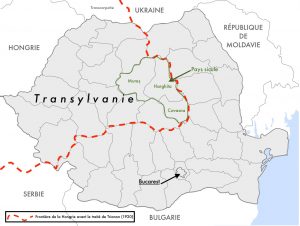 The Hungarian government’s massive investments in Transylvania are increasingly controversial in Romania, with the methods of financing and the objectives pursued by Budapest generating debate in the Romanian media and political circles.
The Hungarian government’s massive investments in Transylvania are increasingly controversial in Romania, with the methods of financing and the objectives pursued by Budapest generating debate in the Romanian media and political circles.
The “curse” of Trianon
The Treaty of Trianon of 4 June 1920 was a turning point in Romanian-Hungarian history: it formalized the break-up of the Austro-Hungarian Empire at the end of 1918, as a result of which Transylvania, which had been part of the Empire until then, became part of Romania. In the Hungarian collective memory, this treaty caused a real “trauma,” which is still evident today. Gergely Gulyás, the head of Prime Minister Viktor Orbán’s chancellery, says the pact “still hurts all Hungarians.” In contrast, Katalin Novák, the President of the Republic of Hungary, says that the peace imposed on Hungary over 100 years ago was not just. V. Orbán does not hesitate to display his revisionist tendencies either: at the last match of the Hungarian national team on 21 November 2022, the head of government appeared wearing a scarf bearing a map of Greater Hungary, which includes part of Transylvania.
Hungarians in Romania constitute one of the most significant ethnic minorities in Europe. According to the 2021 census, 1,002,151 people (6% of the Romanian population) are registered as ethnic Hungarians. This ethnic group is in the majority in the counties of Harghita and Covasna, which, together with the county of Mureș, form the historical region of Sicily, which the Magyars of Romania are demanding autonomy from.

The presence of the Magyar community in Romania (map by Dan-Mădălin Pavel, December 2022).
The defense of the Hungarian community’s interests, including at the political level, is ensured by the Magyar Democratic Union of Romania/UDMR, considered by the historian Stefano Bottoni, professor at the University of Florence, as a satellite party of Fidesz. Since its creation in December 1989, the UDMR has participated in the formation of almost all government coalitions and has obtained a significant number of seats in the Romanian Parliament at each legislative election (29 seats in total, in the Chamber of Deputies and the Senate, out of 466 members).
A Hungarian legislative framework bordering on interference
In May 2022, President K. Novák published a statement on Facebook in which she assumed the role of “representative of all Hungarians, regardless of where they live,” inside or outside Hungary’s borders. The Romanian Ministry of Foreign Affairs was quick to react: it contacted the Hungarian ambassador in Bucharest. It explained that one state could not arrogate rights of any kind over the nationals of another state.
However, the issue of Hungarian minorities abroad has been enshrined in the Hungarian Constitution. Article D of the Foundations chapter of the Hungarian Basic Law states: “Bearing in mind that there is one united Hungarian nation, Hungary assumes responsibility for the fate of Hungarians living outside its borders, and shall encourage the survival and development of their communities [...].”
Moreover, Hungarian state institutions with a mandate to assist cross-border minorities have been established at the legislative level (the Commission for National Solidarity) and the executive level (the State Secretariat for Nation Policy). In addition, several research institutes specializing in Magyars living across the border have been established.
Investing billions abroad: a soft power tool
In 2020-2021, 500 million was allocated to Hungarian communities living abroad, mainly through the Bethlen Gábor Fund, a public foundation of the Hungarian state in charge of managing funds to support Hungarian minorities in the Carpathian Basin and the diaspora. Almost 50 percent of these funds went to the Transylvanian Magyar community through foundations and associations run by people close to the UDMR leadership, such as the Pro Economica Foundation. However, according to an official Romanian document, it is impossible to determine the precise amount of funds allocated by Hungary to the Magyar minority in Romania, given the “complex nature of the funding, the multitude of funding sources and modalities, and the frequent changes in the structure of the funding system.”
These funds are intended to finance various projects in various sectors, some of which receive special attention because they promote traditional and conservative values dear to the Hungarian government. Thus, more than 500 places of worship, many of them historical monuments representative of the Hungarian community in Romania, have been restored in recent years with Budapest’s money, in most cases complementing the European funds obtained (e.g., the Church of St. Michael in Cluj-Napoca). For each project, sums ranging from 90,000 to 1.8 million euros have been invested, with the Reformed Diocese of Transylvania being the primary beneficiary (almost 40 million euros in 2020). In Transylvania, the Hungarian churches are distinguished by the fact that they manage a whole network of schools: the operation of a public education service entirely in Hungarian and placed almost exclusively under the supervision of the churches is a unique phenomenon in Europe, following the example of the Protestant Theological Institute in Cluj-Napoca or the Reformed High School in Târgu Mureș.
Education is another area to which Budapest devotes substantial funds. Viktor Orbán sees schools as crucial for the survival of Hungarians and for training young graduates committed to their homeland. For example, between 2017 and 2021, Budapest funded the Sapientia Foundation’s operation for over €70 million. The Foundation - whose director is Kató Béla, Bishop of the Reformed Diocese of Transylvania - runs the Sapientia University, an autonomous institution of the Hungarians in Romania located in several cities in Transylvania. In addition, there are kindergartens and primary, secondary, and high schools.
Sport is another area in which Hungary is a “trusted partner,” according to Eduard Novak (UDMR), the Romanian minister dedicated to it. Since 2006, nearly 84 million euros have been invested by the Hungarian government in Romanian sports infrastructures: stadiums, ice rinks, and football, basketball, and hockey academies. “Sport is one of the main ways of preserving and strengthening national identity and pride,” says Péter Szijjártó, the Hungarian minister of foreign affairs and trade. The sports competitions in which Budapest-funded clubs (such as Sepsi OSK or Csikszereda) take part are an opportunity to promote specific political ideas, which are strongly contested in Romania, to the local Magyar community, notably the autonomy of the Sicilian country: during the matches, the players and the stand frequently sing the anthem and wave the flag of the Sicilian country. In May 2022, during the World Hockey Championship in Slovenia, the Romanian national team (mainly composed of players of Magyar origin) provoked indignation after singing the anthem of the Sicilian country instead of the Romanian one.
However, in July 2022, V. Orbán stated that the Hungarian government would not launch new cross-border investments in the next two years and that Budapest would focus on completing ongoing projects.
Actions and reactions
The source and purpose of this funding were the subjects of intense debate in the Romanian media in August 2022. Following revelations made by the Digi24 television channel, Romanian Environment Minister Tánczos Barnastated that these sums constituted legal funding of which the Magyar community was not the only beneficiary. He said that the budget was based on applications made by Romanian associations and foundations to the entities in Budapest, according to specific criteria. According to him, the UDMR never used these funds to finance its political activities.
Romanian politicians’ opinions on the subject remain divided. The President of the Chamber of Deputies and the Social Democratic Party, Marcel Ciolacu, said that “the Romanian state should [...] stop complaining”; the Romanian Minister of Tourism, Constantin-Daniel Cadariu (National Liberal Party), also felt that “any injection of capital is welcome.” In contrast, Romanian President Klaus Iohannis referred to these controversial investment projects during his meeting with K. Novák in Bucharest in September 2022, stressing that it was “fundamental that projects of interest be carried out in Romania only after Romania’s agreement, that they not be discriminatory based on ethnicity, and that they comply with Romanian, European and international law.” The Romanian Minister of Foreign Affairs reiterated this idea during an official visit to Hungary in November 2022: Bogdan Aurescu recalled that Hungarian investments should cover the whole territory of Romania.
On the one hand, the Romanian government fears that the Hungarian community feels better represented by the Budapest government than by the Bucharest government; on the other hand, it raises the question of a potential conflict of interest - what interests does a Romanian minister (especially of Hungarian origin) defend when he accepts funds from a foreign government through a foundation or association he manages? On the Hungarian side, the financial support given to Hungarian minorities living abroad is transformed into image capital by politicians in Budapest, who, according to S. Bottoni, act according to a plan that does not aim to change borders, but consciences.
Thumbnail: Viktor Orbán (Capture video/Facebook).
* Dan-Mădălin Pavel is a student in the Master 2 International Relations program at INALCO, specializing in studying Central and Eastern European countries and the post-Soviet world.
Link to the French version of the article
Translated from French by Assen SLIM (Blog)
